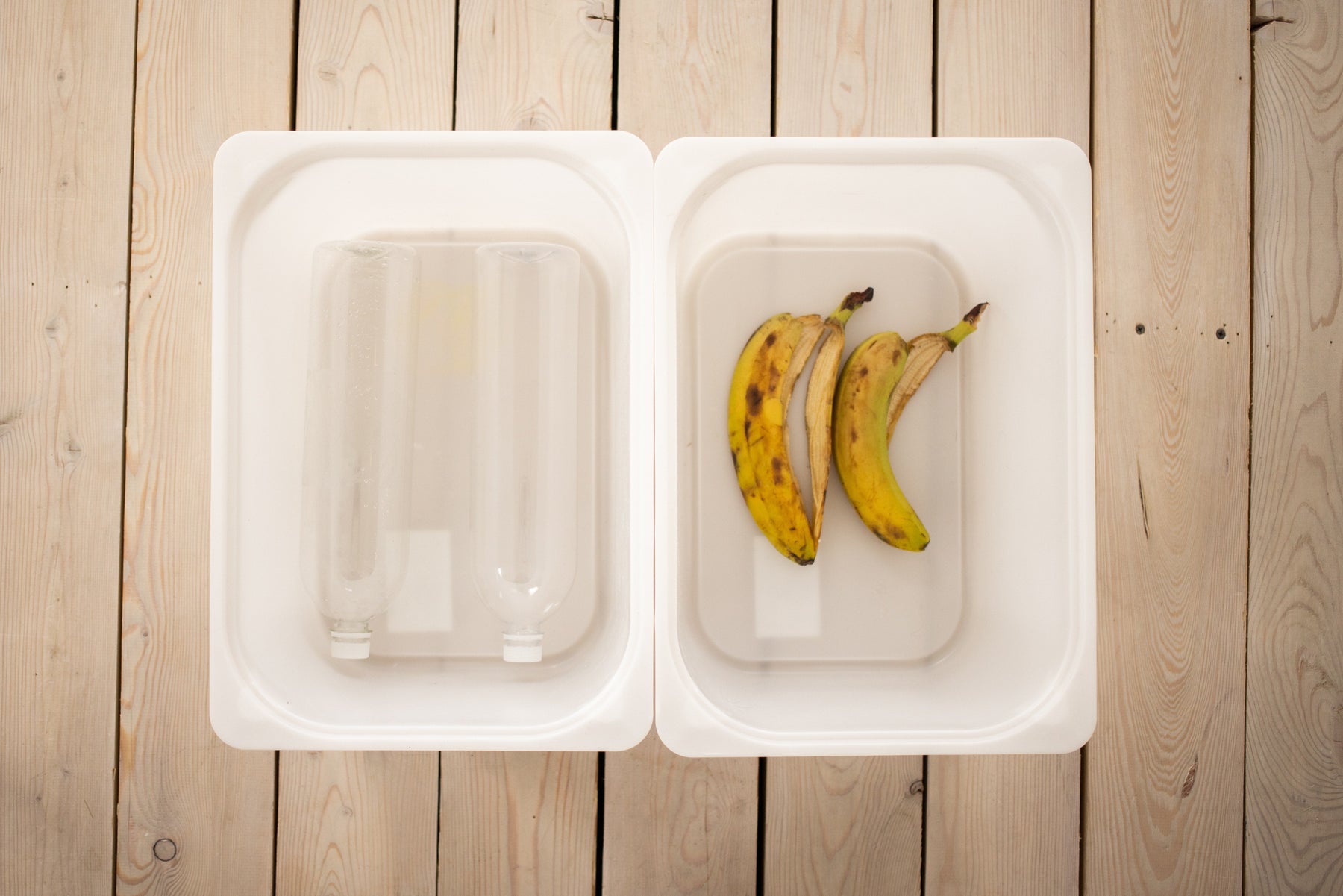Support:
+49 (0) 89 24418362

Recycling of bioplastics
Recycling of bioplastics
Almost 40 percent of all packaging that is produced in Germany every year is made of plastic. In view of this mass, manufacturers have increasingly relied on bio-based and biodegradable plastics in recent years. Because of their positive qualities. These offer advantages in many areas and represent a real alternative to the classic plastics made from fossil raw materials.Definition: Recycled and biodegradable plastics
A distinction is made between bio-based and biodegradable bioplastics. While bio-based means that the material is made at least in part from biomass such as sugar cane, corn or cellulose, biodegradable describes a biochemical process in which naturally occurring microorganisms convert the material into natural substances. These include carbon dioxide and microbial biomass, but also water.Some plastics have both properties, i.e. they are both bio-based and biodegradable. Plastic can be divided into four groups based on the properties and origin of the material. The overview shows that bio-based plastics are not necessarily biodegradable and, conversely, biodegradable plastics are not always bio-based.
Production of bio-based plastics
Bio-based plastics are made from various raw materials, often containing starch and cellulose, such as sugar cane, corn, and sometimes also oilseeds or wood. Biodegradable plastics can also be made from plant-based raw materials - especially cellulose, sugar and starch. The most important sources of starch include corn, wheat and potatoes.The currently most common bioplastics are based on thermoplastic starch. Their share of all bioplastics is around 80 percent. Starch plastics are mainly used for the production of foils, coatings and injection molded articles.
Polylactide (PLA), also known as polylactic acid, has also established itself. This is a biodegradable polyester that is polymerized from lactic acid using corn starch. PLA is widespread in the medical field and is increasingly being used as a packaging and fiber material.
Polyhydroxy fatty acids (PHF) are also among the most popular bioplastics. These are thermoplastic polyesters that are formed with the help of bacteria or fungi
be obtained from sugar or starch. The microorganisms store the PHF so that it can then be extracted from the cells. Depending on which substrate and which bacteria are used, numerous plastics with different properties can be obtained from PHF.
Properties of bioplastics
Bioplastics are mostly made from biogenic substances. Externally, however, they usually do not differ from conventional plastics. Petrochemical and bio-based as well as biodegradable plastics are also very similar in terms of material properties. In principle, they can therefore also be processed into the same products.The vegetable raw materials from which bio-based plastics are made are climate-neutral and therefore environmentally friendly. When evaluating climate neutrality, however, the entire production chain - from raw material cultivation to disposal - must be analyzed. If plants from conventional cultivation are used, the argument of climate neutrality falters. The dinitrogen monoxide (NO2) produced during fertilization is particularly harmful to the climate. Nevertheless, it should be noted that thanks to the sustainable production and disposal chain, the ecological balance is positive compared to traditional plastics.
On the other hand, plastics that are both bio-based and biodegradable can look forward to a particularly positive environmental effect. The biomass required for their production can be composted, making it available to new plants and helping to bind CO2 in the soil. Even if the bioplastics end up in a waste incineration plant, the incineration only produces as much CO2 as the plants previously absorbed.
Disposal of bioplastics
Unfortunately, bioplastics are often not so easy to dispose of. Composting is not possible on the home compost heap. Instead, composting them requires an environment only found in industrial composting facilities. The problem: Many plants do not accept bioplastics, as these are known to have a comparatively long decomposition time. So you would need a separate recycling system - or the bioplastics would have to be further developed in such a way that the decomposition time would be shorter.The best option for disposing of bioplastic waste is energy recovery. Energy is gained from the combustion process of single-variety bioplastics - but sometimes also those that are mixed with certain traditional plastics. This also avoids the consumption of primary fossil fuels and the emissions that are released when they are burned.
FAQ
Are bio-based plastics more sustainable than conventional plastics?
Comparative life cycle assessments of different products show that the environmental impact of items made from bio-based raw materials is not significantly better than that of fossil-based ones. Instead, there is a shift in the effects: Although conventional, fossil-based plastics release more CO2, the production of bio-based plastics shows a higher risk of acidification and eutrophication. The reason: Certain areas are required for the agricultural production of bio-based art. As a result, there may be competition with food production, and there will be fewer compensation areas.
How much "organic" does a bio-based plastic have to contain?
There are no specifications for this. There are certification systems that specify certain ranges for the carbon content of the respective material. However, the term "bioplastic" is not officially defined and is not protected by law.
What are the advantages of bioplastics?
Bioplastics reduce CO2 emissions as they reduce the consumption of petroleum, natural gas and coal. Even when burned, they only release as much CO2 as was originally stored in them, making them significantly more climate-friendly than conventional plastic.
In the future, bioplastics are to be increasingly produced from agricultural by-products and waste products - for example sawdust or feathers. This would also increase their ecological balance. However, the following still applies: Less plastic - regardless of whether it is organic or not - is the best way to protect the environment. Reusable solutions are therefore a very good solution.
How should bioplastics be disposed of?
Under no circumstances should bioplastics be disposed of in the yellow bin or on your own compost heap. Products that are labeled "bio-based" or "biodegradable" belong in the residual waste instead - and sometimes in the organic waste bin. This also means, for example, that organic waste should not be collected in a biodegradable plastic bag.
By law, it is permitted to dispose of compostable plastic in the organic waste bin. Before doing so, however, you should definitely ask the city or the local waste management company how to deal with bioplastics. The reason: Many composting facilities are not able to compost compostable material for three months. However, this period is required by law. In addition, bioplastics in the plant are usually recognized as normal plastic and are therefore sorted out. There is also a risk that the waste disposal company will leave the bin because there is plastic in it.
Are bioplastics recycled?
Yes, but only partially. Bio-based plastics that have the same chemical structure as their fossil relatives are recyclable. For example, PET bottles, which are at least partly based on biomass, can be recycled together with normal PET bottles. The recycling rate of such bottles can be between 26 and 100 percent in closed material cycles.
Bio-based plastics, on the other hand, whose chemical structure differs from that of fossil-based plastics, are not as easy to recycle. It is true that they can usually be deformed thermoplastically and thus fulfill an important requirement for recycling. Unfortunately, sorting systems are usually not designed for sorting such new types of plastic. The plastics therefore very often end up in incineration and are energetically recycled. Sources
https://www.umsicht.fraunhofer.de/en/positions-discourse/recycling-biokunststoffe.html#:~:text=Facts%20and%20Recommendations%20on%20recycling%20%20%20bioplastics%201.4%20Pfandl%C3 %Solutions%20like%20z.%20...%20Other%20articles...%20
https://www.umweltbundesamt.de/biobasis-biologische-degradable-plastics#12-what-do-biobased-and-biologically-degradable-plastics-consist
http://www.biokunststoffe.de/index.php?option=com_content&view=article&id=51&Itemid=47&lang=de
https://www.umweltbundesamt.de/sites/default/files/medien/publikation/long/3834.pdf
https://www.kunststoffe.de/a/Basisnartikel/polylactid-pla-264462
https://www.kompost.de/fileadmin/user_upload/Files/HUK-Files/7_2016/Entsorgung_v_on_Producten_aus_Bioabfaellen_HUK_07_2016.pdf
-
Product title
Original priceOriginal price €19,99€19,99€16,80Current price €19,99 -
Product title
Original priceOriginal price €19,99€19,99€16,80Current price €19,99 -
Product title
Original priceOriginal price €19,99€19,99€16,80Current price €19,99 -
Product title
Original priceOriginal price €19,99€19,99€16,80Current price €19,99 -
Product title
Original priceOriginal price €19,99€19,99€16,80Current price €19,99





